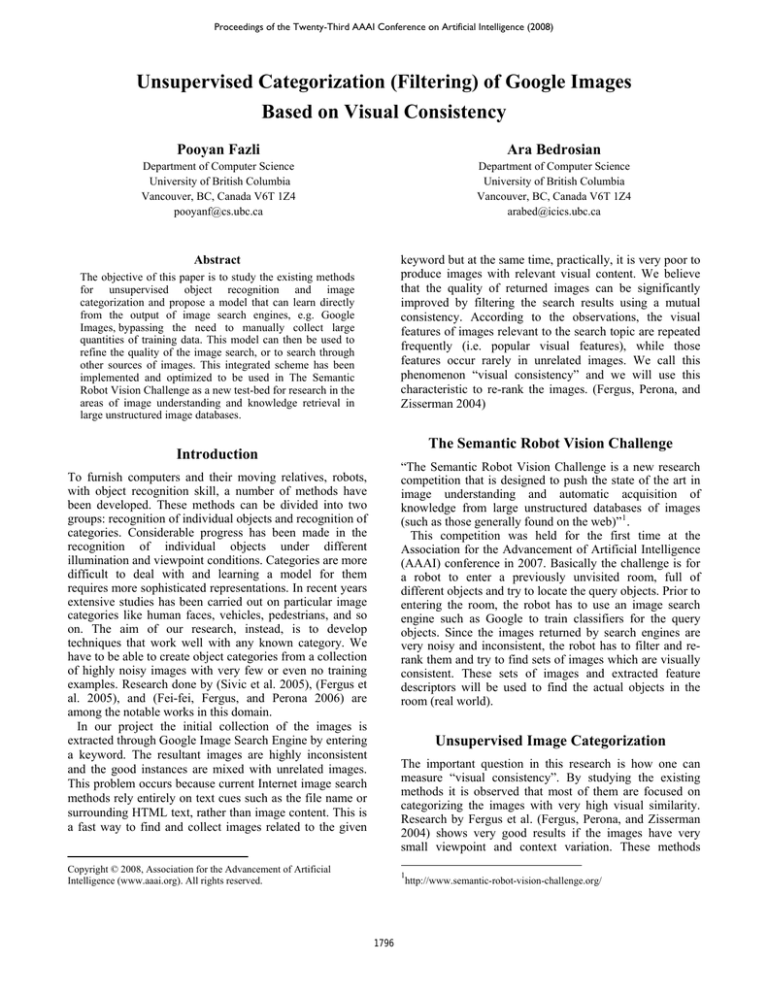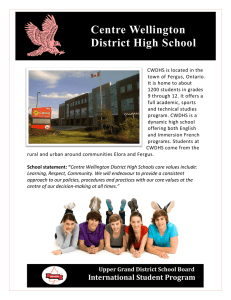
Proceedings of the Twenty-Third AAAI Conference on Artificial Intelligence (2008)
Unsupervised Categorization (Filtering) of Google Images
Based on Visual Consistency
Pooyan Fazli
Ara Bedrosian
Department of Computer Science
University of British Columbia
Vancouver, BC, Canada V6T 1Z4
pooyanf@cs.ubc.ca
Department of Computer Science
University of British Columbia
Vancouver, BC, Canada V6T 1Z4
arabed@icics.ubc.ca
keyword but at the same time, practically, it is very poor to
produce images with relevant visual content. We believe
that the quality of returned images can be significantly
improved by filtering the search results using a mutual
consistency. According to the observations, the visual
features of images relevant to the search topic are repeated
frequently (i.e. popular visual features), while those
features occur rarely in unrelated images. We call this
phenomenon “visual consistency” and we will use this
characteristic to re-rank the images. (Fergus, Perona, and
Zisserman 2004)
Abstract
The objective of this paper is to study the existing methods
for unsupervised object recognition and image
categorization and propose a model that can learn directly
from the output of image search engines, e.g. Google
Images, bypassing the need to manually collect large
quantities of training data. This model can then be used to
refine the quality of the image search, or to search through
other sources of images. This integrated scheme has been
implemented and optimized to be used in The Semantic
Robot Vision Challenge as a new test-bed for research in the
areas of image understanding and knowledge retrieval in
large unstructured image databases.
The Semantic Robot Vision Challenge
Introduction
“The Semantic Robot Vision Challenge is a new research
competition that is designed to push the state of the art in
image understanding and automatic acquisition of
knowledge from large unstructured databases of images
(such as those generally found on the web)” 1 .
This competition was held for the first time at the
Association for the Advancement of Artificial Intelligence
(AAAI) conference in 2007. Basically the challenge is for
a robot to enter a previously unvisited room, full of
different objects and try to locate the query objects. Prior to
entering the room, the robot has to use an image search
engine such as Google to train classifiers for the query
objects. Since the images returned by search engines are
very noisy and inconsistent, the robot has to filter and rerank them and try to find sets of images which are visually
consistent. These sets of images and extracted feature
descriptors will be used to find the actual objects in the
room (real world).
To furnish computers and their moving relatives, robots,
with object recognition skill, a number of methods have
been developed. These methods can be divided into two
groups: recognition of individual objects and recognition of
categories. Considerable progress has been made in the
recognition of individual objects under different
illumination and viewpoint conditions. Categories are more
difficult to deal with and learning a model for them
requires more sophisticated representations. In recent years
extensive studies has been carried out on particular image
categories like human faces, vehicles, pedestrians, and so
on. The aim of our research, instead, is to develop
techniques that work well with any known category. We
have to be able to create object categories from a collection
of highly noisy images with very few or even no training
examples. Research done by (Sivic et al. 2005), (Fergus et
al. 2005), and (Fei-fei, Fergus, and Perona 2006) are
among the notable works in this domain.
In our project the initial collection of the images is
extracted through Google Image Search Engine by entering
a keyword. The resultant images are highly inconsistent
and the good instances are mixed with unrelated images.
This problem occurs because current Internet image search
methods rely entirely on text cues such as the file name or
surrounding HTML text, rather than image content. This is
a fast way to find and collect images related to the given
Unsupervised Image Categorization
The important question in this research is how one can
measure “visual consistency”. By studying the existing
methods it is observed that most of them are focused on
categorizing the images with very high visual similarity.
Research by Fergus et al. (Fergus, Perona, and Zisserman
2004) shows very good results if the images have very
small viewpoint and context variation. These methods
Copyright © 2008, Association for the Advancement of Artificial
Intelligence (www.aaai.org). All rights reserved.
1
http://www.semantic-robot-vision-challenge.org/
1796
discard all the images which are not similar or close to the
mainstream images. The other issue with using these
methods is the time required to learn the categories models.
Most of the existing methods require a relatively long time
to be able to build up an internal model before starting to
do the recognition and classification part. Our research
aims to develop a method which is fast, reliable and a
perfect candidate to deploy in mobile robots.
Based on our specific challenge we need to consider all
the images representing our query object with different
shapes, styles, and pose variations. By doing this we will
be able to provide enough visual code words for our robot
to assist him in locating the requested object in the room
during the competition. We also need to be able to discard
the unrelated images based on the fact that they might not
be repeated in the search results and there is not any
specific relationship between these irrelevant images.
Using this assumption we collect the (visual) features from
all images, where we keep the popular ones and discard the
rest. This will serve as the basis for ranking the images. To
make sure that these features are representing the main
characteristic of our queried object, we will use a set of
“background” (or negative) images to refine our collected
visual feature set.
not added to the feature histogram. At the end, the list of
top-ranked images is returned based on the sum of the
scores of the features that have been appeared in those
images. A sample of the re-ranked images is shown below:
Figure 1. Original input images (Left) and re-ranked output
images, circles show the popular features (Right).
Conclusion and Future Work
We have run a comprehensive set of tests with different
values and image sets to tune the parameters for maximum
performance. The preliminary results show that our method
can manage to learn a model on manually constructed
image collections with added noise and also on raw Google
images with an acceptable accuracy. To extend this work,
we would like to create a set of synthetic images where we
can run our algorithm against them to measure the quality
of the filtered image sets. This will give us a benchmark to
compare different variations of the algorithm in a
controlled environment.
For future work we intend to use other methods of
interest point extraction and also consider spatial
configuration (Shape and Geometry) of the features
relative to each other. More sophisticated clustering
algorithms can be used to find the “densest area” in the
features space. Linguistic techniques based upon related
words in the text of the webpage containing the image
could also be employed to identify and remove mislabeled
images.
Proposed Approach
In our approach images are collected for a keyword
(Positive Data) using Google image search engine or from
known databases. The same program is used to collect
clutter images (Negative Data). Some pre-processing work
is done to fix the size of the images and convert them to
gray scale. The DoG-SIFT keypoint detector (Lowe 1999)
is then used for feature extraction to collect data from the
two sets of our sample images (Positive and Negative
data). During the approach three measures are computed
for every feature:
• Score: Popularity of the feature among the images
• Positive Match Number: Number of similar
features to this feature in sample images
• Negative Match Number: Number of similar
features to this feature in Clutter Images
To organize the features, we have implemented a flat
histogram and features are added to the histogram one by
one. The KD-Tree method is used to sort the features based
on their distance (SIFT difference) from the new feature
being added to the histogram. After identifying a close
match all the features within 5% distance of the match are
selected and their scores are increased based on the
measure of their similarity to the new feature (Positive
Match). The score and Positive Match Number of this new
feature are also initialized based on the scores and Positive
Match Number of the nearest features. If the distance is
more than a predefined threshold, none of the scores are
changed and just this feature is added as a new one to the
histogram. For negative matches, the nearest features
scores are decreased based on the measure of their
similarity to the new feature and also negative features are
References
Fei-Fei, L., Fergus, R., and Perona, P. 2006. One-shot
Learning of Object Categories. In IEEE Trans. PAMI, Vol
28(4), pp. 591-611.
Fergus, R., Fei-Fei, L., Perona, P., Zisserman, A. 2005.
Learning Object Categories from Google’s Image Search.
In Proc. ICCV, pp. 1816-1823 Vol. 2.
Fergus, R., Perona, P., and Zisserman, A. 2004. A Visual
Category Filter for Google Images. In Proc. ECCV,
Springer-Verlag, pp. 242-256.
Lowe, D. 1999. Object Recognition from Local ScaleInvariant Features. In Proc. ICCV, pp. 1150–1157.
Sivic, J., Russell, B. C., Efros, A. A., Zisserman, A.,
Freeman, W. T. 2005. Discovering Object Categories in
Image Collections. In Proc. ICCV.
1797





